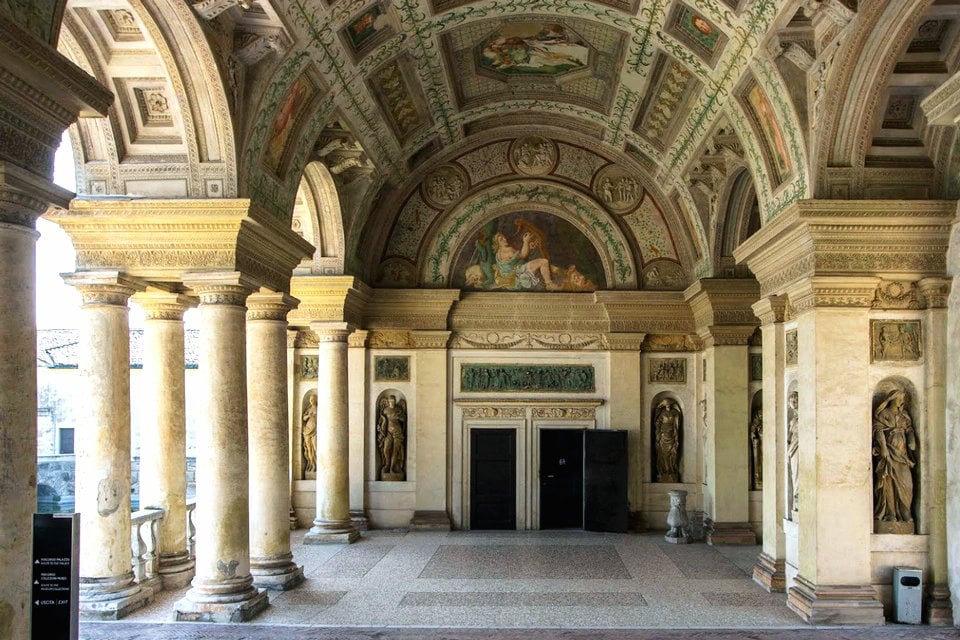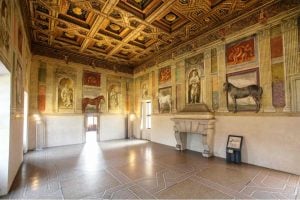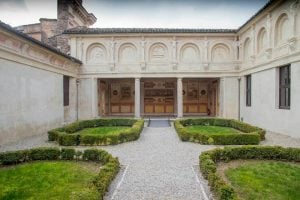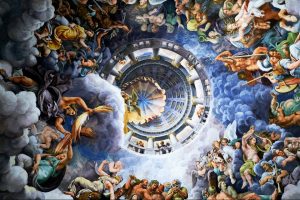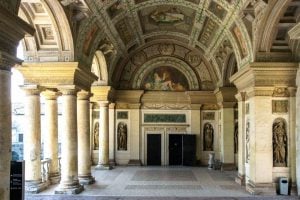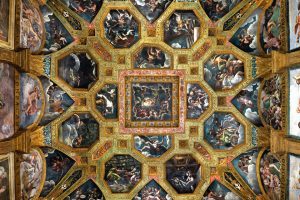Loggia of honor of David: is the loggia overlooking the fishmongers, parallel to the “Grande” which marks the entrance of the building and shows the enchanting view of the garden that is closed to the north by the exedra. The vault is divided into large squares with frames of marsh reeds in which the biblical story of David is represented, scenes taken between 1531 and 1534. The decoration of the lodge lasted until the nineteenth century. The 14 niches were embellished with as many stone statues depicting the personifications of the Virtues taken from the Iconology of Cesare Ripa, a work several times published, from 1593 to 1630. It was in 1653 that Duke Carlo II Gonzaga Neversto commission the statues for the most part, nine, made by the Bolognese sculptor Gabriele Brunelli. The last five statues were made in 1805. Also the workshop of Brunelli executed bas-reliefs together with Francesco Agnesini
A place where all paths cross: the loggia opens up to the garden on one side, on the other it gives onto the cour d’honneur. It was admired by Charles V during his second visit to Mantua in 1532. The protagonist of the scenes decorating the loggia is not a legendary figure but a character from the Old Testament. He is both the captain defending Israel and the young hero defeating Goliath, who is in love with the beautiful Bathsheba. The frescoes are the work of various painters: Luca da Faenza, Rinaldo Mantovano, Fermo da Caravaggio, Benedetto Pagni. Worthy of note are also the stuccoes and the sculptures representing the Virtues, which date to the seventeenth century.
From the loggia we pass into the sunny garden, enclosed by an exedra, that dates to a different period. The style of the Loggia is inspired by the prototype of the Roman villa created by Raphael. This place had a series of different functions: it was a place for recreation, it was meant to glorify the Prince; furthermore it was the ideal place to stage theatrical performances; finally it is the place that best sums up and represents the whole Palace. Here the rhythm created by the frescoes and the decorations respond to the complexity of the architecture.
David
David is described in the Hebrew Bible as the third king of the United Monarchy of Israel and Judah, after Ish-bosheth. In the biblical narrative, David is a young shepherd who gains fame first as a musician and later by killing the enemy champion Goliath. He becomes a favorite of King Saul and a close friend of Saul’s son Jonathan. Worried that David is trying to take his throne, Saul turns on David. After Saul and Jonathan are killed in battle, David is anointed as King. David conquers Jerusalem, taking the Ark of the Covenant into the city, and establishing the kingdom founded by Saul. As king, David commits adultery with Bathsheba, leading him to arrange the death of her husband Uriah the Hittite. Because of this sin, God denies David the opportunity to build the temple, and his son Absalom tries to overthrow him. David flees Jerusalem during Absalom’s rebellion, but after Absalom’s death he returns to the city to rule Israel. Before his peaceful death, he chooses his son Solomon as successor. He is honored in the prophetic literature as an ideal king and the forefather of a future Messiah, and many psalms are ascribed to him.
The appearance of the Palace
Giulio Romano’s genius is visible in the way he treats the several surfaces of the magical square he considers the heart of Palazzo Te. Stylistic variations, shadow effects and architectural elements form some of main attractions of the Palace, visible every day and in all seasons.
Around the Palace
When approaching the Palazzo the first thing that becomes visible at a distance is a low building with a light colour. Getting closer the visitor will then make out openings, windows, frames, and more in general, decorative elements that cover every facade. The genius of the painter and architect Giulio Romano, favourite pupil of Raphael, who arrived in Mantua in 1524, consists in mixing and innovating different styles from ancient buildings. His friendship with the Marquis Federico Gonzaga lead to the development of various projects and to the idea of creating a magnificent building intended for idleness and pleasure, where parties could be held, and that in general would have celebrated victorious battles and been a tribute to the ancient Rome they both descended from. Federico Gonzaga had in fact been kept prisoner inside the papal residence as a child, and had the opportunity to come into contact with the genius of Raphael, whose paintings adorned the walls of this residence, and where he is also very probably depicted.
The famous villa was erected in the sixteenth century on an island at the edge of the city, close to the fourth lake, the lake of Paiolo. The villa is an important element in the political project of Federico, who was made Duke by the Emperor Charles V during a visit to the city and to the palace in 1530. Giulio Romano interpreted the intention of Federico and created a building that is characterized by a perfect geometrical balance. The edifice is tall, its contour is not invasive, allowing the building to blend in with its surroundings. The overall harmony is more Greek than Roman, and is characterized by a Doric austerity.
One of the distinguishing features of the work of Giulio Romano is the continuous search for a variation in the modules he uses, that are chosen not on the basis of their structural function, but for the dynamic quality they are able to impress upon the whole building. Giulio Romano here demonstrated that it is possible to create something totally new by juxtaposing, in an almost musical way, diverse elements taken from past examples. This miracle is achieved by making small changes to the a prefixed order, following a poetics of vision and of its illusions. This is the invention, both in painting and in architecture, of Mannerism, a path that already Raphael, who died at a young age in 1529, had opened up when he had substituted the copy of nature with the invention of something artificial, creating a second nature that was totally human.
A perfect shape
The square cour d’honneur was designed by Giulio Romano. To the west and east are two imposing gates, while to the south and north there should have been a loggia – though only on one side the loggia was realized, called Loggia delle Muse. A third Loggia looks out towards the garden from the east gate, enclosed by an exedra, perhaps added by Nicolò Sebregondi (Sondrio 1585, Mantova 1652) in 1651. The palace is surrounded by a double perimeter, an internal one, which coincides with the cour d’honneur, and a second one that is the garden. The two squares are separated by two large rectangular pools, which evoke the two lakes on the outskirts of the city: in the Sixteenth century these artificial stretches of water separated the palace from the mainland making this an island.
The Loggia of the Muse seen from the outside is an example of the architecture of Giulio. The systematic use of the “bugnato” technique creates movements on the surface of the palace, creating during the different seasons a game of shadow and light, captivating both in the summer and in the winter, as well as during the night. The material in which the Palace is covered seems able to accommodate the natural light of the ambient. Everything is inside a rigid sequence, contained in a clear geometrical setting.
Standing inside the garden and looking from east, the exedra behind us, we see Palazzo Te reflected in the water of the two pools. Also visible from here is the Loggia di Davide, that opens up at the end of the long walk through the rooms of the palace. The loggia also connects the garden to the courtyard.
The east wing of the palace is characterized by a triple arch, held up at the centre by eight columns. The triple opening is balanced by large windows, four on the left and four on the right, which add rhythm to the facade, enhanced by a triangular tympanum, similar to the one of the Pantheon in Rome. The building is reflected in the water, creating yet another artifice.
Giulio Romano is mentioned in The Winter’s Tale by William Shakespeare, making him the only artist to be explicitly referred to. In the words of the British playwright Giulio Romano is the creator of statues that come to life, and is referred to as the“rare Italian master”. Even though Giulio Romano was not a sculptor, his ability to create what today would be called a “multisensorial space”, was indeed understood by Shakespeare, who speaks of a genius able to bring matter to life. Indeed, if Giulio Romano “had he himself eternity and could put breath into his work, would beguile Nature of her custom, so perfectly is he her ape”. These lines are also an accurate and brilliant description of the mannerist style.
Palazzo Te
The Palazzo Te is a historic and monumental building in Mantua. a fine example of the mannerist style of architecture, Built between 1524 and 1534 on commission by Federico II Gonzaga, it is the most famous work of the Italian architect Giulio Romano. The complex is now home to the civic museum and, since 1990, the International Center for Art and Culture of Palazzo Te which organizes exhibitions of ancient and modern art and architecture.
